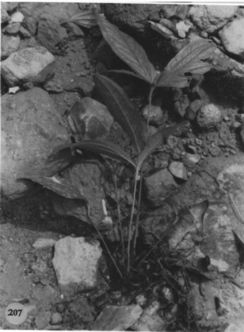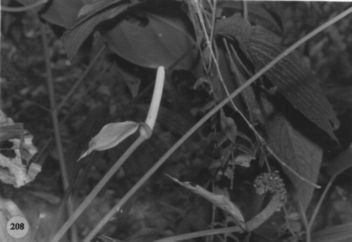


Anthurium trisectum Sodiro
Anales Univ. Centr. Ecuador 20: 100. 1905. TYPE: Ecuador. Esmeraldas: en la orilla del Río San António, Sodiro 8/904 (B, holotype).
Usually terrestrial, sometimes epiphytic, creeping; stems elongate; internodes 1-6 cm long; cataphylls thin, 2-9 cm long, weathering into fine longitudinal fibers, ultimately deciduous.
LEAVES with petioles erect, 18-36(40) cm long, weakly sulcate; blades 3-parted, moderately thin, leaflets sessile or on petiolules to 2 cm long; median leaflet ± elliptic to ovate, 12-25 cm long, 4-11 cm wide, long-acuminate at apex, obtuse at base, lateral leaflets inequilateral ca. two-thirds as long as median leaflet, short-acuminate at apex, inner margin attenuate at base, outer margin rounded; the midrib in the median leaflet sunken above, raised below; primary lateral veins 3-5 per side, sunken above, raised below; departing midrib at 35°-45° angle, the collective vein arising from the base, 3-5 mm from margin.
INFLORESCENCE erect, shorter than leaves; peduncle 9-22 cm long, terete; spathe lanceolate or ovate, green becoming while or yellow, 4-6 cm long, 1.2-2.5 cm wide, acuminate at apex, rounded at base; spadix green to yellow, scarcely tapered, 3.7-5 cm long, 4-6 mm diam. at base: the flowers 4-lobed, ca. 1.7 mm in both directions, the sides sigmoid; ca. 6 flowers visible in the principal spiral, ca. 5 flowers visible in the alternate spiral: lateral tepals 0.9-1 mm wide, the inner margin convex; pistils emergent; stigma elliptic; stamens emerging irregularly throughout spadix, held at edge of tepals; thecae ellipsoid.
INFRUCTESCENCE with spadix to 6.5 cm long, berries violet-purple, globose to ovoid, with a short beak. Figs. 207 and 208.
The species occurs from Costa Rica to Ecuador at elevations from sea
level to 500 m in tropical wet forest life zones. In Costa Rica the species
is known only from the OTS La Selva research area, 100 to 200 m elevation
in Heredia. In Panama, The species is known only from 300 to 700 m elevation
in Code and Veraguas Provinces, principally on the Atlantic slope.
Anthurium trisectum is in section Dactylophyllium
and is distinguished by its usually terrestrial habit and thin, 3-paned
leaf blades with conspicuously impressed veins. No other Costa Rican Anthurium
has completely 3-parted blades and A. trisectum is not closely related
to A. subsignatum, the
only other species tending to have 3-lobed blades.
 |
 |
Map of Mesoamerican specimens with coordinates
Costa Rica Heredia: 200 m,, 5 Feb 1983, Garwood et al. 1158 (BM).
Costa Rica Heredia: 200 m, 10.24.10N 84.03.30W, 20 October 1990, Gina
Umaña & Rafael Chacón 444 (MO).
Costa Rica Heredia: 150 m,, 14 November 1990, Manuel Zumbado 106 (MO).
Costa Rica Heredia: Finca La Selva, 100 m,, , Wilbur 39355 (DUKE).
Costa Rica Heredia: Finca La Selva, 100 m,, , Wilbur 37597 (DUKE).
Costa Rica Heredia: Finca La Selva, 100 m,, , Wilbur 37672 (DUKE).
Costa Rica Heredia: Finca La Selva, 100 m,, , Wilbur 37812 (DUKE).
Costa Rica Heredia: Finca La Selva, 100 m,, , Wilbur 38874 (DUKE).
Costa Rica Heredia: Finca La Selva, 100 m,, , Wilbur 38414 (DUKE).
Costa Rica Heredia: Finca La Selva, 100 m,, , Wilbur 36923 (DUKE).
Costa Rica Lim—n: Chirripo National Park, 1300-2000 m,, 19 Feb 1983,
Garwood et al. 1400 (BM).
Panama CoclŽ: 200-400 m, 8.45N 80.35W, 4 Feb. 1983, C. Hamilton &
G. Davidse 2699 (MO).
Panama CoclŽ: 600 m, 8.45N 80.30W, 7 Feb. 1983, C. Hamilton & G.
Davidse 2878 (MO).
Panama CoclŽ: 150 m, 8.46N 80.27W, 11 Sept. 1987, Thomas B. Croat 67462
(MO).
Panama CoclŽ: 200-400 m, 8.42.43N 80.37.15W, 3 Feb 1983, G. Davidse
& C.W. Hamilton 23518 (MO).
Panama CoclŽ: 130-250 m, 8.46.44N 80.31.54W, 7 Feb 1983, G. Davidse
& C.W. Hamilton 23718 (MO).
Panama CoclŽ: 200 m, 9.47N 80.28W, 9 Dec. 1983, H.W. Churchill, A.
Lier, W.S. Armbruster & A. Herzig 3982 (MO).
Panama CoclŽ: 200 m, 9.47N 80.28W, 9 Dec. 1983, H.W. Churchill, A.
Lier, W.S. Armbruster & A. Herzig 4012 (MO).
Panama Veraguas: 570 m, 08.33N 81.08W, 13 July 1994, Thomas B. Croat
& Guanghua Zhu 76817 (MO).